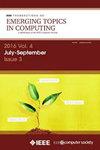主动智能数据迁移的普适边缘计算模型
IF 5.4
2区 计算机科学
Q1 COMPUTER SCIENCE, INFORMATION SYSTEMS
IEEE Transactions on Emerging Topics in Computing
Pub Date : 2025-01-20
DOI:10.1109/TETC.2025.3528994
引用次数: 0
摘要
目前,在物联网(IoT)和边缘计算(EC)的交叉领域,以上下文感知的方式对数据进行智能管理受到了研究界的极大关注。在本文中,我们提出了一种策略,供自主边缘节点采用,这些节点决定将哪些数据迁移到基础设施的特定位置,并支持所需的处理请求。我们的目的是让节点具备学习已卸载数据驱动任务的访问模式的能力,并预测哪些数据应该迁移到任务的原始“所有者”。自然地,这些任务被链接到原始托管节点中不存在的数据处理,这些节点表明需要直接访问所需的数据资产。为了识别这些数据区间,我们采用了一种集成方案,该方案结合了面向统计的模型和机器学习方案。因此,我们不仅能够检测请求的密度,还能够学习和推断“强”数据资产。通过提出相应的公式,并与各自文献中的基线和模型进行评估和比较,详细分析了所提出的方法。本文章由计算机程序翻译,如有差异,请以英文原文为准。
A Pervasive Edge Computing Model for Proactive Intelligent Data Migration
Currently, there is a great attention of the research community for the intelligent management of data in a context-aware manner at the intersection of the Internet of Things (IoT) and Edge Computing (EC). In this article, we propose a strategy to be adopted by autonomous edge nodes related to their decision on what data should be migrated to specific locations of the infrastructure and support the desired requests for processing. Our intention is to arm nodes with the ability of learning the access patterns of offloaded data-driven tasks and predict which data should be migrated to the original ‘owners’ of tasks. Naturally, these tasks are linked to the processing of data that are absent at the original hosting nodes indicating the required data assets that need to be accessed directly. To identify these data intervals, we employ an ensemble scheme that combines a statistically oriented model and a machine learning scheme. Hence, we are able not only to detect the density of the requests but also to learn and infer the ‘strong’ data assets. The proposed approach is analyzed in detail by presenting the corresponding formulations being also evaluated and compared against baselines and models found in the respective literature.
求助全文
通过发布文献求助,成功后即可免费获取论文全文。
去求助
来源期刊

IEEE Transactions on Emerging Topics in Computing
Computer Science-Computer Science (miscellaneous)
CiteScore
12.10
自引率
5.10%
发文量
113
期刊介绍:
IEEE Transactions on Emerging Topics in Computing publishes papers on emerging aspects of computer science, computing technology, and computing applications not currently covered by other IEEE Computer Society Transactions. Some examples of emerging topics in computing include: IT for Green, Synthetic and organic computing structures and systems, Advanced analytics, Social/occupational computing, Location-based/client computer systems, Morphic computer design, Electronic game systems, & Health-care IT.
 求助内容:
求助内容: 应助结果提醒方式:
应助结果提醒方式:


